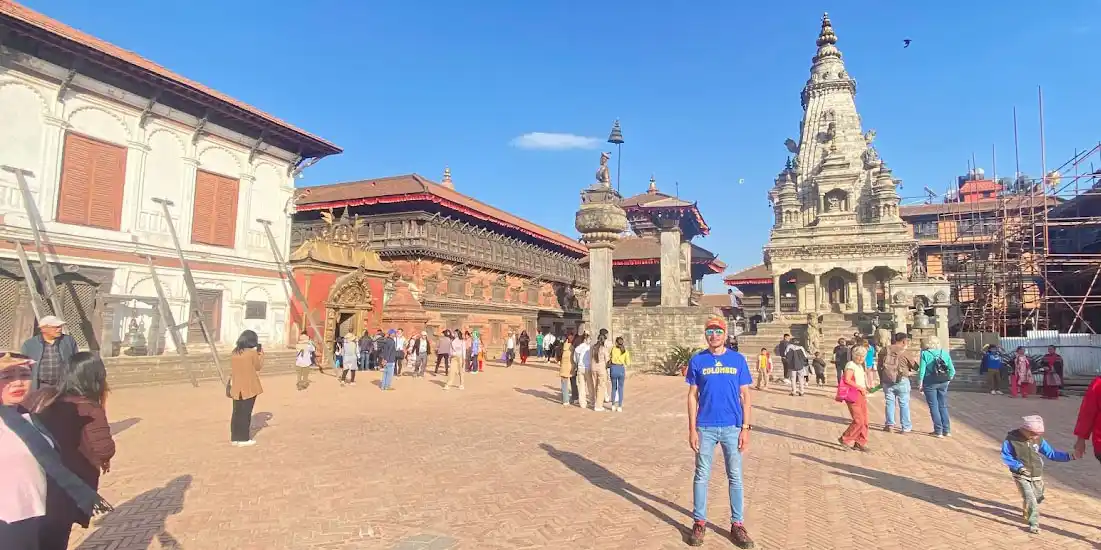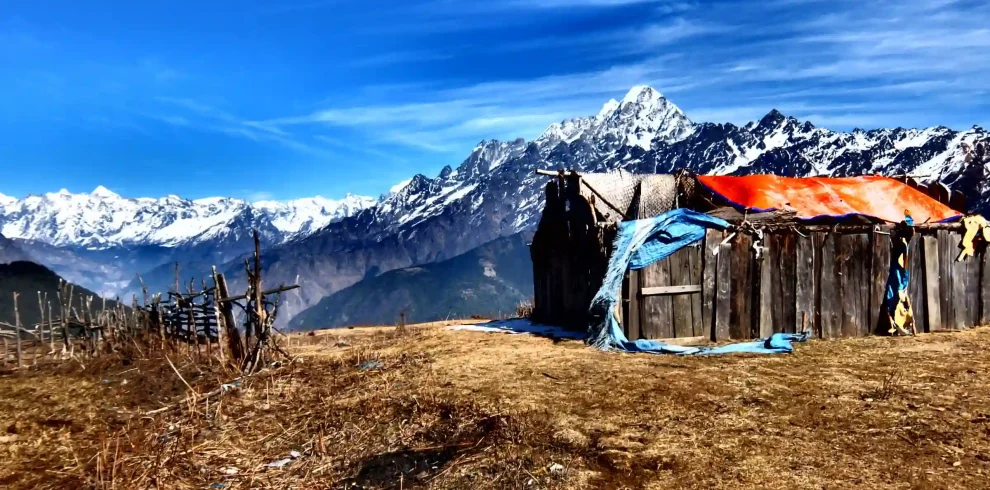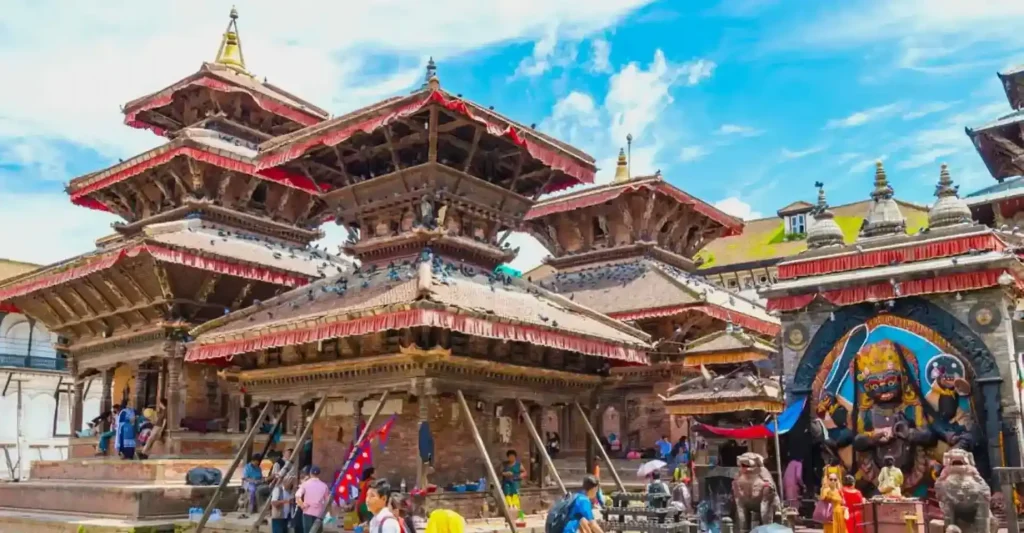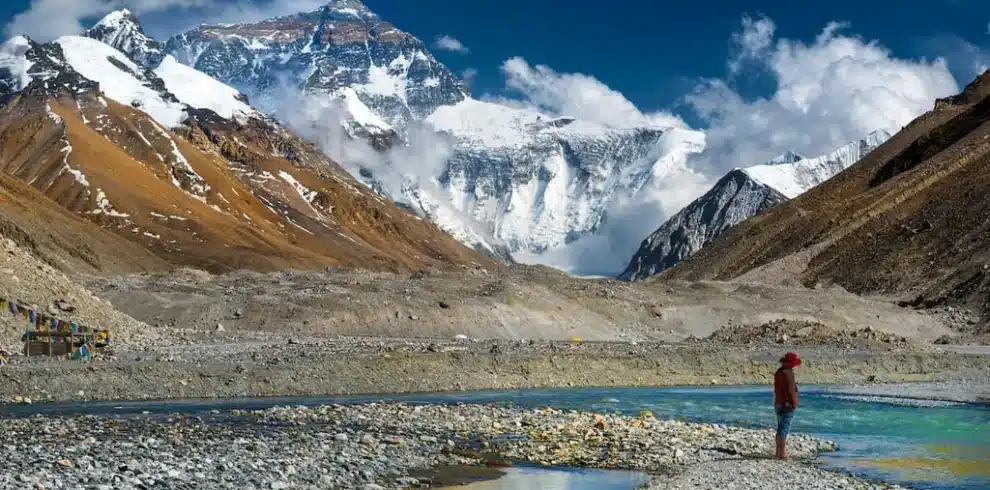Your Nepal Adventure Tour promises an unforgettable blend of culture and exciting activities. The journey begins in Kathmandu, where you’ll explore the UNESCO heritage sites. Your guide will provide insightful stories attached to the stones and buildings.
-
Three stars hotel
-
Kathmandu
-
All around the year
-
Private Vehicle
-
Easy
-
Cultural tour
-
4-20
Nepal Adventure Tour Overview
The Nepal Adventure Tour offers a perfect mixture of the new world seamlessly blending with the traditional lifestyle. Visit to the UNESCO World Heritage sites established around 400 A.D. The Nepal Vacation offers the unique architecture and beliefs of the Hindus in Pashupatinath Temple. Witness the fascinating rituals and ceremonies that unfold on the banks of the Basmati River, gaining a deeper understanding of Nepal’s spiritual essence.
Next, be prepared for the awestruck by Boudhanath Stupa, one of the largest hemispherical structures in the world. Immerse yourself in the Chants of mantras, Mandalas, paintings, and colorful flags.
Bhaktapur Darbar Square makes you feel like you step back in time. Here, the architecture of the ancient Malla Kingdoms unfolds before you. Hand-carved temples in stones and majestic courtyards showcase the unique Newari culture.
Your journey continues to Chitwan National Park, another UNESCO World Heritage site in Nepal. Encounter animals like majestic rhinos, tigers, and graceful deer. The Nepal Adventure tour itinerary offers a crafted and seamless blend of culture, wildlife, and Nepal’s rich tapestry of history in 10 to 11 days. Don’t forget to experience the famous jungle safari in Nepal.
After experiencing the diverse wildlife in Chitwan National Park, your Nepal adventure takes a scenic turn towards Pokhara, Nepal’s second-largest city. Pokhara isn’t just about serene Lakes. Challenge yourself with a hike to Davis Falls, Seti River, Barahi Temple, a charming pagoda, and white-water rafting in Nepal.
As your Nepal adventure Tour nears its end, prepare for exciting trekking in Nepal to ancient villages, navigating rolling hills, and soaking in the scenic route. Experience the mountain bike ride in Nepal around the Kathmandu Valley.
Highlights of Nepal Adventure Tour
- Explore the Kathmandu UNSEO heritage site.
- Hike to Snow-capped peaks, raft wild rivers, and explore hidden caves in Pokhara.
- Immerse in ancient temples, encounter majestic wildlife and experience mountain cycling in Nepal.
- Push your limits and experience Bungee jumping and Paragliding in Nepal.
- Gather the unforgettable experience of the sunrise over Annapurna Mountain.
- Experience the jungle safari and rafting in the Trisuli River.
Itinerary
As you land in Nepal, our team representative will be there to pick you up. They’ll take you to a hotel where detailed trip planning will be discussed with you. Rest in the hotel and enjoy your meal.
Explore Kathmandu’s UNESCO World Heritage sites with a private vehicle and guide on your second day. Visit Kathmandu Darbar square: showcasing Malla reign, Swayamnhunath Stupa (monkey temple), and Pashupatinath temple famous for the Hindu Shrine dedicated to lord shiva. Drive to Nagarkot (2195 m) 1-2 hours drive for further adventure.
Enjoy the morning views from Nagarkot and hike through the Tilkot Forest reserve to Changu Narayan temple, the oldest temple in Nepal. During the afternoon visit Bhaktapur, a city known for traditional wooden architecture built during the Malla reign. Before driving back to Kathmandu explore Bhaktapur Darbaar Square, a UNESCO World Heritage Site with pagodas, Temples, and Palaces.
Your day starts with a delicious breakfast. The drive from Kathmandu to Charundi, the starting point of rafting takes approx. 2-3 hours depending on traffic conditions. Charaundi, the Launchpad for your white-water rafting experience on the Trishuli River. After a day of conquering the rapids, relax and unwind at a comfortable tented camp.
Today holds another thrilling chapter in your Nepal adventure. You’ll conquer the most intense mighty Trishuli Rivers. The journey goes through a scenic drive to Chitwan National Park. Explore the wildlife and breathtaking landscapes. Later take a scenic village tour experiencing the vibrant culture and traditions of Tharu people. Settle into the wildlife lodges and rest for the night.
After a breakfast buffet to refuel, embark on a scenic 45-minute walk through the lush Greenland’s and verdant forests upstream of the Narayani River. As you gently float along the riverbanks, keep an eye out for crocodiles and other animals. Your trip continues with the jeep safari, and witness the park's diverse landscapes. Conclude your trek in Chitwan with a nature walk or a boat ride and back to the camp and have dinner.
After exploring the Chitwan, you’ll embark on a Pokhara. Board a comfortable tourist bus and enjoy the 3-4 hours drive to Pokhara “the city of Lake”. As you reach Pokhara, witness the majestic and breathtaking views of the Himalayas and charming Countryside villages. Check into your comfortable hotel and settle in for a well-deserved rest.
Your Pokhara sightseeing tour promises scenic beauty and cultural immersion. Your tour to Pokhara starts with Phwea Lake and the stunning Annapurna Reflection on it. Visit Davis Falls and Gupteswar cave which is about 3-km-long and has a unique rock formation. Visit Museums like the Local Cultural and Gurkha Memorial Museum along with the Tibetan Refugee camp. Check in at your hotel for a well-deserved rest and enjoy your meal.
Our trip to Pokhara ends today, after breakfast, we will drive back to Kathmandu. The 7-8 hours drive to Kathmandu goes through the scenic landscape. You’ll have free time in Kathmandu in the evening, explore the city, shop, or even scroll along the street. Overnight stay at the hotel.
Prepare for the ultimate cycling adventure on Kathmandu Valley’s single track. Today’s trek covers approximately 70 Km in 6-7 hours, combining exhilarating climbs and satisfying downhill. During the evening enjoy a delicious and festive dinner at a fine restaurant with your guide and office staff.
Your Nepal tour adventure ends today. Our team representative will escort you to the airport approximately 3 hours earlier.
Our team guides, porters, and accompanying staff are locals with a broad knowledge about each and every location that we travel through.
The Cost Includes & Excludes
Cost Includes
- Pick up and drop at the hotel by private/tourist bus.
- Two-night stay at the 3-star hotel including breakfasts, (private room can be organized as per requests on added costs by the clients)
- Permits and fees for temples, parks, monasteries, and cultural sites are included too.
- Two days of rafting in Trishuli River, Trekking camping equipment (tents, Mattresses, dining tents, kitchen tents, etc.)
- Healthy full board meal including seasonal fruits.
- Friendly and trusted city guide in Kathmandu and Pokhara.
- Fees and taxes.
- Road Maps and assistance guide for clients.
- A farewell dinner on your last night in Nepal.
Cost Excludes
- Meal wish list except for breakfast, lunch, and dinner.
- Personal expenses, altered schedule for personal reasons.
- International flight fare and departure tax.
- Nepal tourist visa-free.
- Snacks and drinks including water during trekking.
- Travel as well as emergency evacuation coverage.
- Tips for potters, drivers, and staff.
Packing lists for the Nepal Adventure Tour
- Base layers: Opt for quick-drying, moisture-wicking thermals like merino wool or synthetic fabrics.
- Mid-layers: Pack fleece or down jackets for warmth and insulation.
- Trekking pants: Convertible pants that transform into shorts.
- Hiking socks: Choose thick, wicking socks to prevent blisters.
- Underwear: Opt for breathable, moisture-wicking underwear.
- Hat: Bring a warm hat for chilly mornings and evenings.
- Gloves: Pack a pair of warm gloves for cold weather.
- Hiking boots: Sturdy, hiking boots with good ankle support.
- Camp shoes: Lightweight sandals or Crocs for relaxing around camp.
- Sunglasses: Choose sunglasses with UV protection.
- Sunscreen: Pack a broad-spectrum sunscreen with SPF 30 or higher to protect your skin from the sun’s harmful rays.
- Lip balm: A lip balm with SPF protection will keep your lips hydrated and prevent sunburn.
- First-aid kit: Pack a basic first-aid kit with essential medications like pain relievers, bandages, and antiseptic wipes.
- Cash: While some teahouses accept credit cards, it’s wise to carry some local currency for emergencies and smaller purchases.
FAQ on Nepal Adventure Tour
A Nepal Adventure Tour typically includes thrilling activities such as trekking (e.g., Everest Base Camp, Annapurna Circuit), wildlife safaris in Chitwan or Bardia National Parks, white-water rafting, UNESCO World Heritage sites including Pashupatinath Temple, Bhaktapur Darbar Square, etc.
The duration of a Nepal Adventure Tour range from 7 to 11 days. However, customized tours can be shorter or longer based on your preferences and the specific adventures you wish to experience.
The best times for a Nepal Adventure Tour are spring (March to May) and autumn (September to November). These periods offer favorable weather conditions, clear skies, and moderate temperatures, making them ideal for trekking and other outdoor activities.
Yes, you may need special permits depending on the activities and regions you plan to visit. For trekking in areas like the Everest or Annapurna regions, you will require permits such as the TIMS (Trekkers’ Information Management System) card and national park permits. For certain adventure activities, additional permits or licenses may be required.
The cost of a Nepal Adventure Tour varies widely based on the duration, activities included, and level of service. An introductory adventure tour may cost between $1,000 and $3,000 per person. Customized tours with high-end services or extended activities can be more expensive.
During a Nepal Adventure Tour, accommodations range from basic teahouses and lodges to luxury hotels and resorts. The type of accommodation will depend on your chosen activities and destinations. Basic lodges are typical in remote trekking areas, while a wide range of hotels is available in major cities like Kathmandu and Pokhara.
While hiring a guide is optional, having a professional guide can enhance your experience, especially for remote trekking or adventure activities. Guides provide valuable local knowledge, ensure your safety, and help with navigation and logistics.
Altitudes during a Nepal Adventure Tour can vary greatly depending on your itinerary. For example, treks like Everest Base Camp reach elevations of around 5,364 meters (17,598 feet), while activities in lower regions like Kathmandu and Pokhara are at much lower altitudes. Proper acclimatization and preparation are essential for high-altitude activities.
Essential Info
Physical Fitness
Many people have questions as to what level of physical fitness is required for visiting Nepal, and that is extremely reliant on what activity the visitor is engaging in. With that said, for a standard trek of moderate grading (Everest Base Camp Trek is an example of moderate) the daily activity will be 7-8 hours, and elevation will generally not exceed 5,500 meters. The day’s trekking is sustained and will involve both long steep climbs, and descents with a variety of terrain underfoot from well-trodden paths, to rocks covered with ice or snow. A typical day would include a number of climbs or descents of 500 meters or more, starting after breakfast, resting at lunch, then continuous trekking until arriving at the teahouse.
In preparation for the trek, it is important to begin a training requirement at least 4 months before departing for Nepal. Three to four hours of aerobic exercise like running, walking, swimming, cycling & some gym work per week is the minimum and most will find it beneficial to add some basic strength training to their physical fitness routine. One of the best ways to prepare is to take practice hikes with a daypack roughly the same weight as what you will be taking on the trek. Do this only after a baseline of fitness has been reached. Moving fast is not the end goal, rather endurance is the focus, and will provide a more enjoyable and safe adventure.
Trekking Seasons in Nepal
There are two main seasons in which Nepal sees the most amount of visitors. Fall (September through November) being the most popular, and spring (March to May) coming in close behind. The summer months of June, July and August are the monsoon season and as such the trails are mostly washed out, and roads can sometimes be impassible due to landslide activates. Not to mention the view is non-existent. Still, there are a few places that lie in rain shadow areas and see significantly less rain if any at all, and summer can be a good time to visit these places.
Winter in Nepal is dry, with very cold nights where temperatures can drop to -20°C at the highest altitudes, but the days are pleasant and sunny. Additionally, the trails are much less crowded during this time of year. In Kathmandu, maximum daytime temperatures reach around 20°C.
Fall is the most popular because it’s after the monsoons, and the air is dry, the days are sunny, and everything is green in the lower valleys from the excessive rains. Spring is a popular choice because some rain returns, but the weather is generally warm and dry, and flowers are in bloom in the lower elevations.
Trekking Day
A typical trekking day begins with a cup of tea at around 6 in the morning. It is advised to pack your trekking gears in a duffle bag and essential supplies in your day pack in these early hours. After having breakfast, we begin the trek and head along the trail at around 8 am. The morning walk is designed to be longer as we begin with refreshed bodies and enthusiasm. Following a good morning’s walk, we make stop for lunch at around 11.30 am. The lunch involves group meals enjoying the vicinity around the stop. You can explore the surrounding or use the time according to your own consent. After resting for about an hour or two, we resume our trek to reach teahouse or camp by 3-4 pm. The afternoon walk is relatively shorter and can involve games and side trips as organized by the trekking guides. You also can enjoy breaks during the trek to relax, read or stroll around the area. You can converse with the local people and observe their lifestyle. Dinner is served around 7 in the evening to round off the day.
Meals and Accommodations
During the length of the trek, the accommodation style is commonly referred to as teahouse. These are family-run basic lodges that fill the role of the restaurant, meeting place, and boarding house for tourists. Electricity can be found in the rooms, which means one light bulb, and one or two outlets for charging electronics. The common areas are also lit by electricity. Teahouses may use solar, hydroelectric, or have electrical lines running into the village, so the commonality and availability of electricity may vary.
Most teahouses have private rooms, though if the trek is in a more remote or high altitude place dormitories are the norm. Each room has 1 or 2 single beds with basic bedding, and the bathroom is shared. Expect a mix of western and squat style toilets in the bathrooms.
Breakfast and dinner are taken at the teahouse and these lodges have large family style dining rooms centered on a stove to provide heat. The menu will have Nepali style western foods such as pasta, pizza, pancakes, burgers, and fries. Also on the menu is the traditional Dal Bhat meal. This is a lentil soup with rice and vegetable or meat curry. Most menus will also offer a smattering of local cuisine.
Internal Flight Delays
Nepal is an incredible country of mountains and valleys, rivers and green rolling hills. With this incredible diversity of landscapes, road travel can be extremely time consuming and flights within Nepal to reach popular trekking destinations is a must. Along with this mountainous terrain also comes the possibility of in climate weather. Not to mention the incredibly high number of visitors during peak seasons makes internal flight delays a very real possibility. To manage this possibility, it may be helpful to have a few extras days on either end of your tour. If any cancellations or flight delays do occur (high chances of flight delays from around Kathmandu to Lukla, Everest region), we also provide services to arrange helicopter to help you to be on your schedule on the premises of Civil Aviation Rules in Nepal which state that helicopters can fly if the visibility is 1500m. The cost ranges from USD350 to USD650 according to the number of passengers. The payment can be made either to the helicopter company or to us directly and can be made either by cash or using a credit card. It will also be helpful to purchase and review your insurance as some of the alternative measures for travel may be covered. Flight insurance too may cover changing your international flight if necessary.
Travel Insurance
Many expeditions and tours require that travel insurance is purchased prior to arriving in Nepal, but other treks and tours may not. However, travel insurance is definitely an important consideration. There are a number of reasons to consider insurance. Firstly, it may be required, so check to see what is being asked for by the company. Second, Nepal is a landlocked country, and there are few direct flights. Travel in and out can encounter some disruptions and if purchasing insurance, make sure flight delays and cancellations are included. The next reason to choose insurance is that, though every safeguard is in place during your tour, there are always extenuating circumstances that may result in an accident. Read the fine print of insurance policies to ensure trekking or any other activity you are engaging in is covered, as some policies have stopped covering trekking in certain places. It is impossible to have a relaxing trip without the comfort of good insurance, so do the research and choose carefully.
Nepal Visa Entry Procedure
For entry into Nepal, there are visa requirements everyone (except Indian nationals) must complete before being allowed to pass through immigration. This is for air travel as well as overland transportation. Most visitors may obtain a visa to enter Nepal, however, there are exceptions.
Three options are available for entry
15-day single entry: US $30
30-day single entry: US $50
90-day multiple entries: US $125
Please have a passport valid for at least 6 months from the time of entry, and have cash ready, preferably in US dollars, though there are other currencies Nepal Immigration accepts. If you are entering via overland, you must have US cash and 3 passport photos. For arrival by air, the kiosks at the airport take your picture for you.
For the most up to date list of exceptions for visa on arrival or to obtain the most current visa information, visit the Nepal Department of Immigration website.
Acute Mountain Sickness (AMS)
Acute Mountain Sickness is usually seen in un-acclimatized people shortly after ascent to high altitudes. The condition occurs due to the thinning of air as the altitude increases. The condition, if not taken seriously and treated immediately, can be life-threatening and its symptoms can be seen generally above 3000 meters. Some of the symptoms of AMS are nausea, vomiting, tiredness, shortness of breath and cerebral pain. The treks are designed to properly acclimatize you to the change in high altitude climate and sufficient precautionary measures too are taken to take utmost caution. We also equip our staffs with cell phones and satellite phones in occurrence of any emergency cases. We are greatly driven to keep the safety and security of our clients as our foremost concern.
Drinking Water
Water is essential for life, and clean water is imperative while on holiday. When choosing to visit less developed countries it is a concern that all travelers should consider. A few options are available when trekking or traveling in Nepal that will mitigate any chances of drinking contaminated water which could cause disruption of an otherwise fun adventure. The first consideration to take into account is that tap water should not be ingested. That even means when brushing your teeth. Most will choose to buy bottled water and if doing so make sure the cap has not been opened previously. Plastic bottle refuse is a problem, and with that being said there are other options on the market to assist in making water drinkable. Your local outdoor store can help with choosing what option might be best to use in conjunction with a reusable bottle. Your guide can also steer you to water that has been filtered and purified so ask him or her what is available.
Arrival Instruction
Upon your arrival at Tribhuvan International Airport, our company representatives are stationed to welcome you to the country. We request you to carefully look for your name being held by our representatives following the events upon landing. The representatives are responsible to escort you to your hotel in Kathmandu. You will see men offering you to carry luggage and take you to your destination as you exit the airport. We request you pay no attention to these people and follow the designated representatives and follow their instructions. You will also need to keep an eye on your luggage and belongings to avoid any complications.
Traveler Reviews
These genuine and honest reviews are provided by travelers who have previously journeyed with Aarohi Holiday and its team. The testimonials and firsthand experiences showcased here are sourced from well-known travel platforms such as TripAdvisor, Google, Facebook, and TrustPilot, etc.




